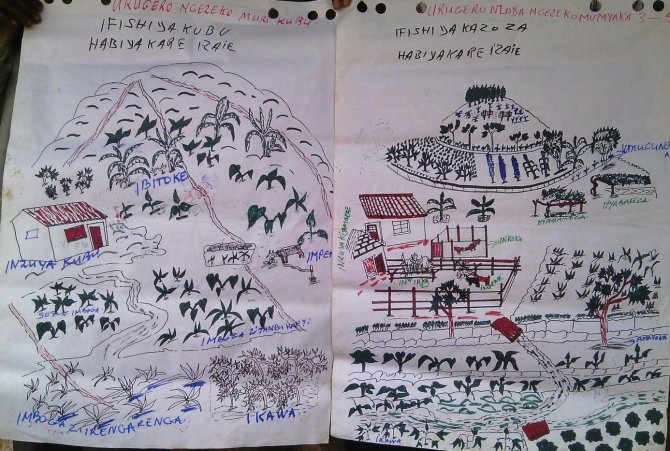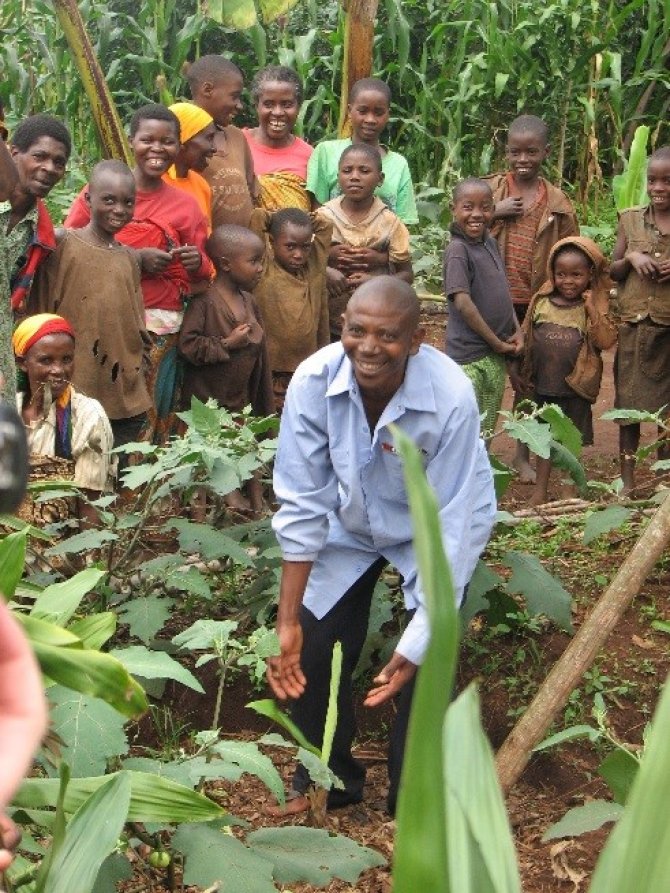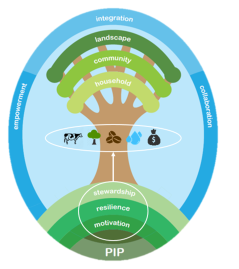
The PIP approach: building a foundation for sustainable change
The PIP approach, as currently applied in e.g. Uganda, Burundi, DRC and Ethiopia, is an inclusive bottom-up approach that engages people in environmental stewardship and sustainable change. It focuses primarily at smallholder farmer families, by motivating them to “draw, plan and act together” to improve their farm, land and household; not only on the short-term, but particularly also with long-term (restoration) actions, fostering sustainability.
Creating a PIP, the Participatory Integrated Plan drawn-up by each family and every village, is the core activity in the PIP approach. The PIP brings people together, with common goals, and with the mindset and agency needed to transform their reailty. In East Africa this already has resulted in hundreds of thousands farmers determent to make their vision become reality, building together their own foundation for sustainable change.
Origin and evolution of the PIP
The PIP (Plan Intégré Participatif in French) is a drawing or vision of a better future, which motivates people to act and transform their reality. Creating a PIP changes mindsets: from short to long-term visions, from passive to engaged, from seeing problems to seeing opportunities. The ownership of this plan and of all resulting actions is key, because only then people can actually contribute to sustainable change.
The approach originated in Bolivia at the beginning of this century, upon seeing the incapability of (majorly top-down) development programmes to tackle the root causes of land degradation at scale. In 2014 the PIP was first piloted and then further developed in Burundi, facing the same challenge “how to motivate and mobilize people at scale to restore their living environment”.
This was the start of an exciting journey in which the PIP developed in 10 years from a merily farm-household approach to an intervention strategy that engages stakeholders at all institutional levels in sustainable change, from the bottom-up! Although we still put smallholder farmers with their families and communities at the centre, nowadays the PIP also motivates all other actors involved to become responsible stewards of the land and its natural resources: all working together towards sustainable change!
Process and principles of the PIP
A PIP, the Participatory Integrated Plan, consists of a drawing of the current situation, the desired future situation (the vision for 3-5 years) and an action plan. This is primaily done for smallholder farms and households (see figure below), but can also be done for villages, schools, watersheds, districts/municipalities, farmer groups, etc. Creating a PIP is the glue that binds people together, and wishing to achieve their common goal is what keeps them together!
Although creating a PIP looks easy, it is a process that can take several weeks to months. Learning is central in this process: by creating a PIP people constantly learn from their family members, neighbours, friends and project staff, on how to improve, do better and reach their vision. It is a continuous process, of people becoming increasingly aware of their problems and potential solutions, followed by visioning and planning, to eventually undertake motivated action; based on their own capabilities and knowledge, but learning from others, together!

The PIP tree below shows how to conceptualize the approach. Just like a tree that needs a strong foundation – with fertile soil for its roots – the PIP approach builds a solid foundation for sustainable change. In this foundation we find the three PIP foundation principles: motivation, stewardship and resilience: motivated people who foster resilience and good stewardship of the land and its natural resources. This is essential for the sustainability of any intervention or action to be implemented: e.g. livestock improvement, reforestation, value chain development, water projects or micro-credit schemes (visible in the stem of the tree). Hence, unlike most other “development” approaches, PIP works from the bottom-up to tackle the root causes of environmental degradation and poverty – with the people, adressing their needs!
Getting involved in PIP
Wageningen Environmental Research is the founder of the PIP approach and has over the past years developed it into a practical and widely applicable tool. We collaborate with numerous other organisations in East Africa, such as ZOA, Red een Kind, Woord en Daad, DORCAS, MAX Foundation, IFDC, GOAL and SNV, and of course with local NGOs in Uganda, Burundi and Ethiopia.
We are currently developing Modules for all the different phases and steps of the PIP approach, which will replace the PIP Manual from 2020: these will become available soon on the new PIP website www.pipapproach.com.
For more information check out the documents available in the PIP Library, and videos, farmer testimonies & best practices in the PIP Gallery.

